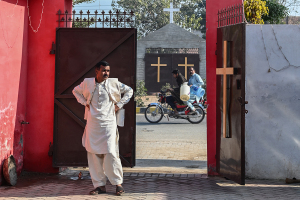St. Patrick: Banish the Blarney Then Let His Life Inspire You Today

A number of years ago there was a character featured on Saturday Night Live which just celebrated it's 40th anniversary on TV. A depressed-looking, bug-eyed, frumpy woman named Debbie Downer had a knack for sharing negative information when others were trying to celebrate. Hang with me for a moment as this commentary starts with a Debbie Downer moment.
- Patrick was not Irish.
- As a young man he had no interest in God.
- He never drove out any snakes because there were none in Ireland.
- His use of a shamrock to teach the Trinity is cute for children but it's just a myth.
- There is no such thing as a leprechaun.
- Patrick didn't drink Guinness beer because it didn't exist.
Waaaah Waaaah!
Now I'm not a party-pooper. I enjoy a celebration but enjoy it even more when I understand what's legitimate and what's legend. With St. Patrick's Day and all the green, the parades, parties with Irish stew and toasts to the "luck of the Irish," let's get behind the blarney to focus on an incredible man of God who transformed a nation through the proclamation of the Gospel and the planting of churches.
The Real Story of St. Patrick
Years ago when I ministered in Ireland, I recall the descent of the plane and how absolutely awestruck I was as I beheld for the first time the Emerald Isle. This deep green countryside is the picture conjured up in the hearts and minds of tens of thousands of Irish celebrants who annually dye the Chicago River green for St. Patrick's Day. And in celebrations throughout America this special feast day is a sign of spring, bringing welcome relief after the cold of winter.
But what's really behind this day and the man we honor? After all, he died over 1554 years ago on, guess what, March 17th, 461.
Patrick was born in Britain in 390 A.D. He was raised in a Christian family but his interest in God was almost nonexistent. He also was illiterate.
Teens are often apt to wander and Patrick sure did, reaping the consequences. At the age of 16 he was kidnapped by thugs and taken hostage on a ship to Ireland.
Imagine the trauma and grief his parents experienced while praying for God's miraculous intervention and the return of their son.
What was he doing while being held captive in Ireland? For six agonizing years he was trapped as a slave working as a shepherd on hills where he tended the sheep. He was alone. He was scared. In desperation he began to cry out to God to rescue him from his plight.
Picture your teenage son or daughter on that hillside, trembling and fearful for their very life.
Yet God was at work in Patrick's soul (just as he is in your wayward son or daughter!). In his classic "Confession" he painfully wrote, "I would pray constantly during the daylight hours" until finally God broke through and revealed Himself in a dream and specifically said the following to this young, lost soul, "Your hunger is rewarded. You are going home. Look, your ship is ready."
Risking his life but pierced to the core by the call of God on his life, Patrick journeyed some 200 miles to the Irish coast! He bravely boarded a ship that was going to Britain and he knew instinctively God was taking him back home.
This young "Millennial" returned to his family transformed by the grace of God (wouldn't it be great to see this homecoming captured on video?). In time he even entered a Christian training center, a monastery, to pursue the calling to full-time vocational ministry as a Catholic priest.
Patrick excelled in his understanding of the Scriptures and his character impacted his superiors and peers. Eventually they affirmed him in becoming an overseer/bishop in the Church.
Three decades from his initial abduction, Patrick sensed God stirring his heart. The Holy Spirit was directing him to go back to the pagan land of Ireland to evangelize the people mired in deception and darkness.
Not only would this be an arduous journey as there were no 747s to swiftly carry one to a destination, but this meant facing a hostile culture of pagans known for their angry outbursts and violent behavior.
Next time you hear the term, "Paddy Wagon", think of its origin with the influx of Irish immigrants (nicknamed "Paddies" after Patrick) who not only became policemen, but whose fighting and drunkenness forced pickups in these padded wagons.
Patrick recorded his sentiments as he wrote, "I am ready to be murdered, betrayed, enslaved – whatever may come my way!" May his courage ignite something in our hearts to reject silence and cowardice in the face of our cultural attacks today. May this man's bravery inspire us to speak the truth in love regarding homosexuality, militant Islam, dishonesty, fornication (living together or casual sex), adultery and compromising "Christians" yielding to pornography and a host of carnal indulgences in our day.
"For Zion's sake we will not keep silent, for Jerusalem's sake we will not remain quiet, 'til her righteousness shines out like the dawn, her salvation like a blazing torch." Is. 62:1
In the face of mockery and physical opposition - history records he was beaten by thugs and harassed by Irish royalty - Patrick persevered in proclaiming the Gospel and training converts in their newfound faith. Like John Wesley who would follow in his footsteps a 1000 years later, he also provided for the training of leadership to shepherd the new churches being planted.
As Patrick crisscrossed the countryside, God blessed him mightily. Tens of thousands of Irish were converted and hundreds of churches were established! Thomas Cahill writes in his book, "How the Irish Saved Civilization", through Patrick's courageous leadership, this warrior populace "laid down the swords of battle, flung away the knives of sacrifice, and cast away their chains of slavery."
As we look at the moral decline in America today, it is easy to get discouraged. This is why it's important on St. Patrick's Day to reflect on the exploits of this man of God who was instrumental in saving a nation.
From the fall of Rome, culture was disintegrating on the European continent. Patrick, like Paul the apostle, Wesley, Booth, Wilberforce, Bonhoeffer, Chuck Colson and other fearless Christian activists of whom we read, did not retreat in the midst of overwhelming odds. All of them prayed, preached the gospel, affirmed Biblical Christianity and confronted evil fearlessly. Cahill honors Patrick and other champions of the faith who brought transformation to society. Because of him and others who rose to the occasion, "The Irish not only were conservators of civilization, but became shapers of the medieval mind, putting their unique stamp on Western culture."
100 years after Patrick's death in 461 A.D., multitudes of churches and monasteries remained training future leaders as a testimony to this mighty man of God. His legacy should make us, excuse the expression, "Green with envy."
Here's the Deal: On this St. Patrick's Day, may I encourage you to post and pass along this commentary to many so they'll likewise learn why tribute is given this hero of the Christian faith, 1554 years to the date of his home-going to heaven. Instead of drunkenness and debauchery on this special day, let's humble ourselves and pray that we and our families can follow in Patrick's footsteps.
"When Irish Eyes Are Smiling,
'tis like a morn in Spring.
In the lift of Irish laughter,
you can hear the angels sing."





























